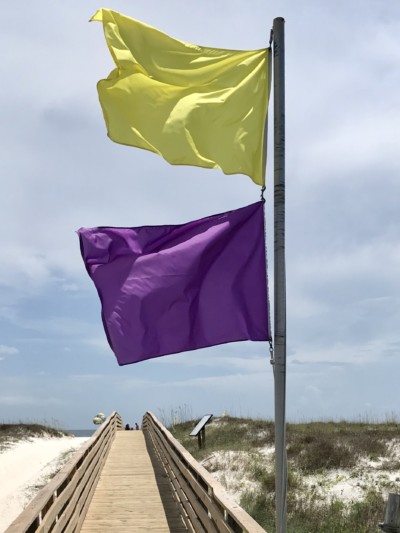 There are many things to be aware of when you’re enjoying a day playing and swimming at the beach. If you take precautions with sunscreen and water safety, observe the warning flags, and practice the Leave Only Footprints program, a fun day at the beach will remain fun!
There are many things to be aware of when you’re enjoying a day playing and swimming at the beach. If you take precautions with sunscreen and water safety, observe the warning flags, and practice the Leave Only Footprints program, a fun day at the beach will remain fun!
Those familiar with the Alabama Beach Warning Flag System probably know what the green, yellow and red flags indicate. But do you know what the purple flag means? The purple flag is flown when dangerous marine life is present.
Dangerous marine life can be anything in the water that is hazardous to humans. Of course, the first thing that comes to mind is sharks. But that is not usually the case. When our beaches fly the purple flags, it’s most likely because of jellyfish. If sharks are spotted in the area and deemed a danger to beachgoers, the double red flags will fly to close the water in that area.
When purple flags are flying, it’s best to stay out of the water. You can still enjoy the beach and play along the shoreline. If you must venture into the water, watch carefully around you and be sure to have supplies on hand to treat jellyfish stings.
When a jellyfish sting happens, the following are the best treatment procedures:
- Don’t rub it. Wash any tentacles away with saltwater. Fresh water will make the stinging worse.
- Treat the area with vinegar or isopropyl alcohol to inactivate the stinging cells.
- A paste made with meat tenderizer is reported to help relieve the pain.
- Anyone stung should be monitored for adverse reactions. If a large portion of the body has stings, seek medical attention.
There are seven species of jellyfish that are common to Alabama waters: sea nettle, moon jellyfish, cannonball, Portuguese man-of-war, oceanic jelly, sea wasp and mushroom jelly.
Stay aware of your surroundings and heed the flag warnings to keep everyone healthy and happy at the beach.

